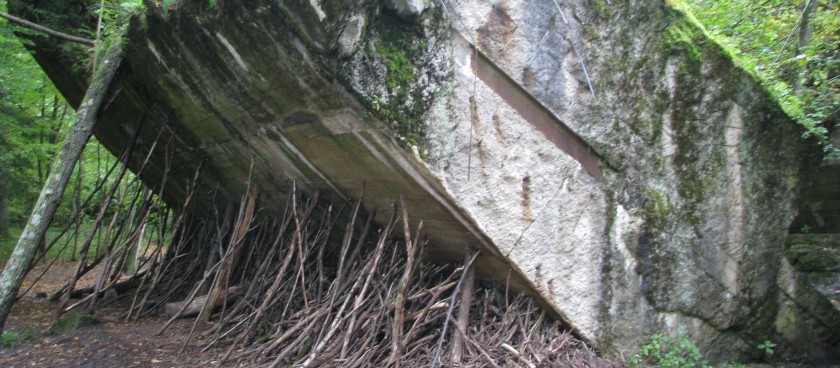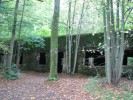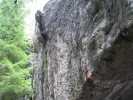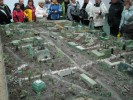- #PL11
- Gierłoż 5, Kętrzyn, Poland
- +48897410031, +48897410021
- wilczyszaniec@olsztyn.lasy.gov.pl
- http://www.wilczyszaniec.olsztyn.lasy...
- Working hours*:
From April 1 to September 30
Daily 08:00 – 20:00
From October 1 to March 31
Daily 08:00 – 16:00 - Prices*:
Sightseeing:
Adult ticket - PLN 15
Discount ticket - PLN 10 (students and students up to 26 years on presentation of the ID card)
Children under 6 - free admission
Large Family Card - PLN 10
Parking for visits:
Coach - PLN 25
Camper, bus - PLN 10
- * - opening and closing times as well as entrance prices, are subject to alterations without notice. Visitors are advised to check before visiting.
- 54.0806980, 21.4942860 Copy to clipboard Copy
-
#History , #Oddities , #Museums
The top secret, high security site was in the Masurian woods about 8 km (5.0 mi) east of the small East Prussian town of Rastenburg (now in Gierłoż, Kętrzyn County, Poland). Three security zones surrounded the central complex where the Führer's bunker was located. These were guarded by personnel from the SS Reichssicherheitsdienst and the Wehrmacht's armoured Führerbegleitbrigade. Despite the security, the most notable assassination attempt against Hitler was made at the Wolf's Lair on 20 July 1944.
Hitler first arrived at the headquarters on 23 June 1941. In total, he spent more than 800 days at the Wolfsschanze during a 3½-year period until his final departure on 20 November 1944. In mid-1944, work began to enlarge and reinforce many of the Wolf's Lair original buildings. The work was never completed because of the rapid advance of the Red Army during the Baltic Offensive in late 1944. On 25 January 1945, the complex was blown up and abandoned 48 hours before the arrival of Soviet forces.
Name
Wolfsschanze is derived from "Wolf", a self-adopted nickname of Hitler. He began using the nickname in the early 1930s and it was often how he was addressed by those in his intimate circle. "Wolf" was used in several titles of Hitler's headquarters throughout occupied Europe, such as Wolfsschlucht I and II in Belgium and France and Werwolf in Ukraine.
Although the standard translation in English is "Wolf's Lair," a Schanze in German denotes a sconce, redoubt or temporary fieldwork.
Layout
The decision was made in late 1940 to build the Wolf's Lair in the middle of a forest, far from major roads and urban areas. The 6.5 km2 (2.5 sq mi) complex was completed by 21 June 1941 and consisted of three concentric security zones. About two thousand people lived and worked at the Wolf's Lair at its peak, among them twenty women, some of whom were required to eat Hitler's food to test for poison. The installations were served by a nearby airfield and railway lines. Buildings within the complex were camouflaged with bushes, grass, and artificial trees on the flat roofs; netting was also erected between buildings and the surrounding forest so that the installation looked like unbroken dense woodland from the air.
Sperrkreis 1 (Security Zone 1) was located at the heart of the Wolf's Lair, ringed by steel fencing and guarded by the Reichssicherheitsdienst (RSD). It contained the Führer Bunker and ten other camouflaged bunkers built from 2 metres (6 ft 7 in) thick steel-reinforced concrete. These shelters protected members of Hitler's inner circle such as Martin Bormann, Hermann Göring, Wilhelm Keitel, and Alfred Jodl. Hitler's accommodation was on the northern side of Führer Bunker so as to avoid direct sunlight. Both Hitler's and Keitel's bunkers had additional rooms where military conferences could be held.
Sperrkreis 2 (Security Zone 2) surrounded the inner zone. This area housed the quarters of several Reich Ministers such as Fritz Todt, Albert Speer, and Joachim von Ribbentrop. It also housed the quarters of the personnel who worked in the Wolf's Lair and the military barracks for the RSD.
Sperrkreis 3 (Security Zone 3) was the heavily fortified outer security area which surrounded the two inner zones. It was defended by land mines and the Führer Begleit Brigade (FBB), a special armoured security unit from Wehrmacht which manned guard houses, watchtowers, and checkpoints.
A facility for Army headquarters was also located near the Wolf's lair complex.
The RSD had overall responsibility for Hitler's personal security, although external protection of the complex was provided by the FBB, which had become a regiment by July 1944. The FBB was equipped with tanks, anti-aircraft guns, and other heavy weapons. Any approaching aircraft could be detected up to 100 kilometres (62 mi) from the Wolf's Lair. Additional troops were also stationed about 75 kilometres (47 mi) away.
Reinforcements
Hitler's secretary Traudl Junge recalled that Hitler spoke repeatedly in late 1943 or early 1944 of a possible bomber attack on the Wolfsschanze by the Western Allies. She quoted Hitler as saying, "They know exactly where we are, and sometime they’re going to destroy everything here with carefully aimed bombs. I expect them to attack any day."
According to Speer, between 28 July 1941 and 20 March 1942, Hitler left Rastenburg only four times for a total of 57 days. Afterwards, Hitler spent the next three months in Obersalzberg before returning to Rastenburg for the next nine months.
Hitler’s entourage returned to the Wolfsschanze from an extended summer stay at the Berghof in July 1944. The previous small bunkers had been replaced by the Organisation Todt with "heavy, colossal structures" of reinforced concrete as defense against the feared air attack. According to Armaments Minister Albert Speer, "some 36,000,000 marks were spent for bunkers in Rastenburg [Wolf's Lair]." Hitler’s bunker had become the largest, "a positive fortress" containing "a maze of passages, rooms and halls." Junge wrote, "We had air-raid warnings every day" in the period between the 20 July assassination attempt and Hitler's final departure from the Wolfsschanze in November 1944, "but there was never more than a single aircraft circling over the forest, and no bombs were dropped. All the same, Hitler took the danger very seriously, and thought all these reconnaissance flights were in preparation for the big raid he was expecting."
No air attack ever came. It has never been revealed whether the Western Allies knew of the Wolfsschanze's location and importance. The Soviet Union was unaware of both the location and the scale of the complex until it was uncovered by their forces in their advance towards Germany in early 1945.
Hitler's daily routine
Hitler would begin his day when he was in residence by taking a walk alone with his dog around 9 or 10 am, and at 10:30 am he looked at the mail that had been delivered by air or courier train. A noon situation briefing was convened in Keitel's and Jodl's bunker and frequently ran for two hours. This was followed by lunch at 2 pm in the dining hall. Hitler invariably sat in the same seat between Jodl and Otto Dietrich, while Keitel, Martin Bormann, and Göring's adjutant General Karl Bodenschatz sat opposite him.
After lunch, Hitler dealt with non-military matters for the remainder of the afternoon. Coffee was served around 5 pm, followed by a second military briefing by Jodl at 6 pm. Dinner could also last as long as two hours, beginning at 7:30 pm, after which films were shown in the cinema. Hitler then retired to his private quarters where he gave monologues to his entourage, including the two female secretaries who had accompanied him to the Wolf's Lair. Occasionally, Hitler and his entourage listened to gramophone records of Beethoven symphonies, selections from Wagner or other operas, or German lieder.





